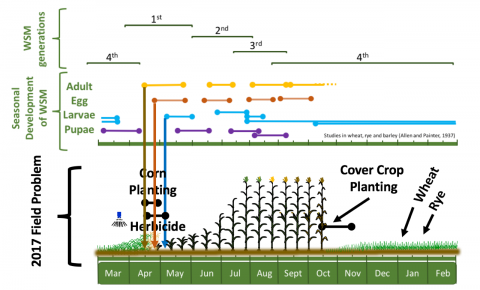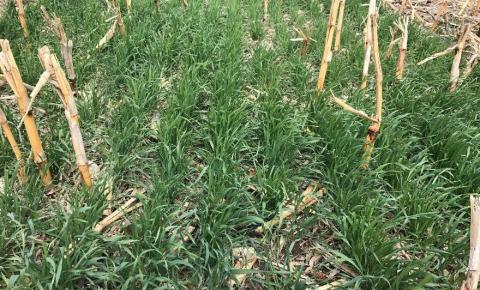Soilborne and Early Seedling Pathogens and Delayed Planting in Corn and Soybean
May 3, 2018
Soilborne pathogens and early seedling diseases may be more frequent in corn and soybean this year due to cool weather conditions this spring and delayed planting.
Corn & Soybean Planting Forges Ahead
April 30, 2018
Seventeen percent of the state's corn had been planted by April 30, behind last year's 32% and the five-year average of 24%, according to the USDA’s National Agricultural Statistics Service crop report. Last week only 2% had been planted.
Soybean planting was 6% done, near last year's 7% and the average of 4%. Last week 1% had been planted.
Wheat Stem Maggot Adult Monitoring: A Pest of Cover Crop-to-Corn Transitions
April 25, 2018
This article looks at wheat stem maggots in cover crops-to-corn transitions, including their biology, risk for damage to early season corn, and what to look for this spring.
Q&A on Terminating Cereal Rye, Applying a PRE
April 25, 2018
A grower asked: My cereal rye cover crop is only 3 to 5 inches tall going into planting season. Can I combine two field operations in one by applying glyphosate to terminate cereal rye and tank-mixing it with a residual herbicide for early season weed control?
Nebraska Corn and Soybean Planting Gets Started
April 24, 2018
For the week ending April 22, the USDA National Agricultural Statistics Service reported corn planting in Nebraska at 2%, behind last year's 15% and the five-year average of 9%.
Corn Disease Update
January 8, 2018
A review of diseases to expect in Nebraska corn for 2018. An article in the 2018 Crop Production Clinic Proceedings.
Nitrogen Fertilizer Stabilizers in Corn
April 19, 2018
Understanding how the three types of nitrogen stabilizers work can be helpful in deciding whether to add one to your spring application. Short- and long-term studies in Nebraska offer insight into how they performed across multiple years. Now, if you only knew how many inches of rain you'd get the first six weeks after application.
Planning Ahead for Winter Wheat: Review Corn and Soybean Herbicide Programs
April 13, 2018
If you're considering planting winter wheat next fall, be sure to review the corn and soybean herbicide programs you plan to use this spring to avoid rotation restrictions that would limit your cropping options.



